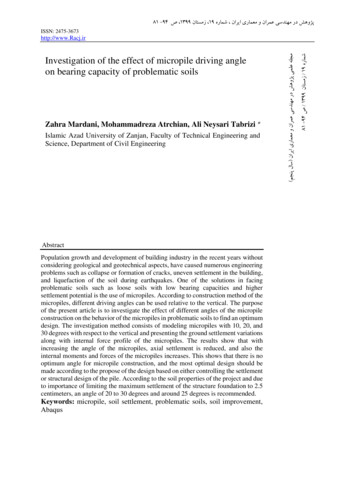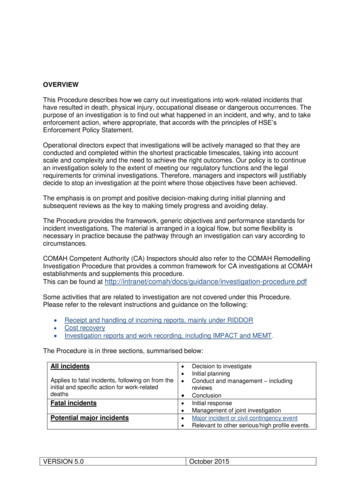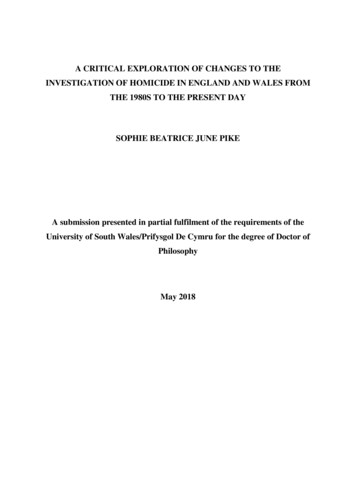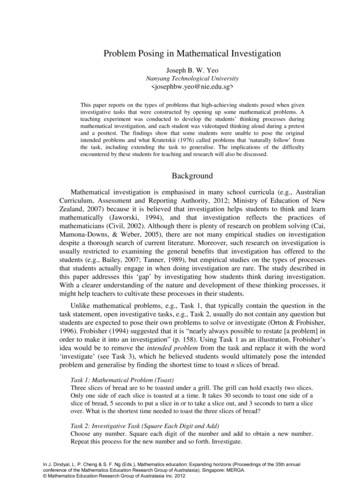
Transcription
81 -94 ص ،1399 زمستان ،19 شماره ، پژوهش در مهندسی عمران و معماری ایران ISSN: 2475-3673Zahra Mardani, Mohammadreza Atrchian, Ali Neysari Tabrizi *Islamic Azad University of Zanjan, Faculty of Technical Engineering andScience, Department of Civil EngineeringAbstractPopulation growth and development of building industry in the recent years withoutconsidering geological and geotechnical aspects, have caused numerous engineeringproblems such as collapse or formation of cracks, uneven settlement in the building,and liquefaction of the soil during earthquakes. One of the solutions in facingproblematic soils such as loose soils with low bearing capacities and highersettlement potential is the use of micropiles. According to construction method of themicropiles, different driving angles can be used relative to the vertical. The purposeof the present article is to investigate the effect of different angles of the micropileconstruction on the behavior of the micropiles in problematic soils to find an optimumdesign. The investigation method consists of modeling micropiles with 10, 20, and30 degrees with respect to the vertical and presenting the ground settlement variationsalong with internal force profile of the micropiles. The results show that withincreasing the angle of the micropiles, axial settlement is reduced, and also theinternal moments and forces of the micropiles increases. This shows that there is nooptimum angle for micropile construction, and the most optimal design should bemade according to the propose of the design based on either controlling the settlementor structural design of the pile. According to the soil properties of the project and dueto importance of limiting the maximum settlement of the structure foundation to 2.5centimeters, an angle of 20 to 30 degrees and around 25 degrees is recommended.Keywords: micropile, soil settlement, problematic soils, soil improvement,Abaqus81 -94 ص / 1399 زمستان / 19 شماره Investigation of the effect of micropile driving angleon bearing capacity of problematic soils) مجله علمی پژوهش در مهندسی عمران و معماری ایران (سال پنجم http://www.Racj.ir
81 -94 ص ،1399 زمستان ،19 شماره ، پژوهش در مهندسی عمران و معماری ایران ISSN: 2475-3673http://www.Racj.irIntroductionThe use of micropiles has increased considerably since the 1950s and especially afterthe mid1980s.Micropiles are basically used as reinforcing elements against static and dynamic loads,reinforcement of slopes, and stabilization of excavation walls. Population growth, increase in housingneeds, and development of building industry without considering geological and geotechnical aspects,has caused many issues with problematic soil being one of the main ones. Collapse or formations ofcracks in the buildings, uneven settlement, liquefaction in case of earthquakes are examples of suchproblems. These issues make geotechnical and geological investigation of the project site, anindispensable part of the job. Generally speaking, there are two main solutions in the hands ofgeotechnical engineers when facing problematic soils such as loose soils with low bearing capacity,big settlements potential, and liquefaction:1- Use of load bearing elements in the soil2- Improvement and correction of physical properties of the soil massEach of the mentioned methods have their own ways and specifications which has been developed duringyears. Some innovative methods are a combination of the methods above, and have the advantagesof both groups of solutionsto some extent. Micropiles can be regarded in this manner.According to recent studies, reasonable performance has been seen in micropiles. However, not enoughstudies have been done in this regard and the need for further research in the field of exactunderstanding of Micropile behavior is necessary and obvious; and this issue has led to utilization ofnumerical analyses such finite element modeling for deeper understanding of micropile behavior. Inthis regard, to study the deeper aspects and existing ambiguities such as effect of passive soil pressure,length, diameter, and angle of the micropile on the micropile-soil system, parametric study of theinclined micropile behavior under vertical static load in a specific soil type had to be done.In the present study, the effect of driving angle of the micropile on improvement of the bearing capacityin a problematic soil with coral structure is investigated, and maximum and minimum optimum valuesdetermined for this parameter. In order to do this, soil and micropile has been modeled in threedimensions using comprehensive finite element programs, and the results has been presented in theform of dimensionless diagrams for further study of these parameters.Parametric study of a single inclined micropile is done in this research. The purpose of parametric studyis to investigate the extent of impact of micropile drivingangle on the response of soil-micropilesystem. To do this, some of the parameters that might have an impact on the system response ischosen, and by keeping the other parameters constant except the studied parameters, system responseagainst the variations of that parameter will be investigated.According to the mentioned points, it is necessary to verify, compare, and calibrate the numericalanalysis of the soil-micropile system with field experiment or previous numerical study results.Hence, three-dimensional finite element analysis modeling was used due to complexity, nature, andasymmetrical geometry of the problem at hand. Therefore, Abaqus Ver. 6.10 finite element programwas used to achieve this.For the surrounding and stabilized soil around the micropile,Mohr-coulombconstitutive model,and the steel casing, concrete, and reinforcing barare considered as elastic.
81 -94 ص ،1399 زمستان ،19 شماره ، پژوهش در مهندسی عمران و معماری ایران ISSN: 2475-3673http://www.Racj.irNumerical modeling and analysisNumerical modeling in this study is done using Abaqus program. First, the process of building themodelis presented and then numerical studies of the thesis will be explained.1. Modeling1.1. Model geometrySurrounding soil is modeled as a 3D cylinder with a radius of 15 meters and depth of 30 meters in PARTmodule and SOLID element and EXTRUSION type.Figure 1. Soil model generationFigure 2. Micropile model generation
81 -94 ص ،1399 زمستان ،19 شماره ، پژوهش در مهندسی عمران و معماری ایران ISSN: 2475-3673http://www.Racj.ir2. Parameter assignmentTo build the soil and micropile model, the parameters mentioned in table 1 have been used. Theparameters have been extracted from a problematic site in south of Iran.For the surrounding andstabilized soil around the micropile, Mohr-coulomb constitutive model, and the steel casing, concrete,and reinforcing bar are considered as elastic. The micropiles have a length of 18 meters, diameter of300 millimeters, and casing thickness of 3 millimeters.a. Upper layer embankment: geotechnical parameters of this layer consists of a coarse-grainedsoil with varying thickness from 0 to 5 meters in the investigated area. With the assumption ofsufficient compaction of this layer and correctness of the plate load test results performedduring the compaction of this layer, the following can be assumed:Es 50 60 MPaElastic modulus of soilC 0 , φ 34 Shear strength paramersb. Porous rock layer (crushed limestone mass): Geotechnical parameters of this layer under theembankment with a thickness of 1 to 7 meters in the studied area is estimated as below:γd 17.0 KN/m3dry densityqa 1.5 2.0 MParock mass compressive strengthqs 4.0 5.0 MPaintact rock compressive strengthqt 1.0 2.0 MPaintact rock tensile strengthEs 150 200 MPaElastic modulus of rock massc. Relatively hard clay layer: Geotechnical parameters of this layer with a thickness of 5 to 9meters which is located between the upper limestone layer and lower compacted Marlrock(claystone), are as follows:γd 18.0 19.0 KN/m3moist soil densityEs 15 20 MPaElastic modulusCu 25 30 KPa , φu 15 undrained shear strength parametersĆ 5 KPa , φ́ 22 Effective shear strength parameters (drained)Cc 0.20Compression indexd. Very hard lower clay layer (claystone): Geotechnical properties of this layer which is identifiedas the lower layer of the drilled borehole is estimated as follows:γd 19.0 20.0 KN/m3moist soil densityEs 50 70 MPaElastic modulusCu 75 100 KPa , φu 10 undrained shear strength parametersĆ 5 10 KPa , φ́ 24 Effective shear strength parameters (drained)Cc 0.12Compression indexTable 1. Parameters related to modeling micropile and soil
81 -94 ص ،1399 زمستان ،19 شماره ، پژوهش در مهندسی عمران و معماری ایران ISSN: 2475-3673http://www.Racj.ir3. Analysis stepsSTATIC RIKS analysis method is used in the in current study. Analysis control is done in two ways inthis method.1- Via displacement of a specific point2- Via the applied load amountA picture of the assumptions made in this analysis in shown in Figure 3.Figure 3. Using STATIC RIKS analysisDefinition of a contact surface is necessary for proper transmission of the forces between the soil andstructure. Strength property is defined in this area by choosing a proper strength reduction value. Thisparameter shows the ratio of the structure strength parameters relative to that of the soil. Therefore,an interface element of “tangential behavior” is defined to cover the contact behaviors with frictioncoefficient of 0.3 as shown in Figure 4.
81 -94 ص ،1399 زمستان ،19 شماره ، پژوهش در مهندسی عمران و معماری ایران ISSN: 2475-3673http://www.Racj.irFigure 4. Using STATIC RIKS4. Boundary conditions and loadingIn the current modeling process, the load is applied as a compressive stress on top of the micropile,boundary conditions of the walls are defined as rollers, and the bottom is defined as fixed.Figure 5. Model loading
81 -94 ص ،1399 زمستان ،19 شماره ، پژوهش در مهندسی عمران و معماری ایران ISSN: 2475-3673http://www.Racj.irFigure 6. Boundary conditions of the surrounding soil5. Mesh generationMesh element type of “Hex” with 20-node quadratic is used for micropile area due to stress concentrationin this place; and mesh element type of “ted” with 4-node linear type is used for the surrounding soil.Figure 7. Micropile mesh generation
81 -94 ص ،1399 زمستان ،19 شماره ، پژوهش در مهندسی عمران و معماری ایران ISSN: 2475-3673http://www.Racj.irFigure 8. Surrounding soil mesh generation6. Discussion and conclusionThe purpose of this article is to investigatethe behavior of inclined micropile and study the effectiveparameters such as inclination angle of the micropile relative to the vertical on the response of soilmicropile system under static vertical load on a bed of coral limestone (problematic soil). Theanalyses are done using non-linear 3D finite element numerical method.6.1. Reference micropile analysis resultsVertical displacement diagramof the soil under vertical load is shown in Figure 9.Figure 9. Vertical displacement diagram of soil and micropile under various loads
81 -94 ص ،1399 زمستان ،19 شماره ، پژوهش در مهندسی عمران و معماری ایران ISSN: 2475-3673http://www.Racj.irBending moment diagram in the length of the micropile is shown in Figure 10.Figure 10. Bending moment diagram along the micropile lengthVertical settlement diagram of the reference micropile is also shown in Figure 11.Figure 11. Vertical displacement diagram along the micropile length
81 -94 ص ،1399 زمستان ،19 شماره ، پژوهش در مهندسی عمران و معماری ایران ISSN: 2475-3673http://www.Racj.ir7. Inclination angle of the micropileGenerally speaking, load transmission is done in two ways in micropiles: 1- frictional and 2- bearing.Hence, from structural point of view, the applied load is decomposed into two axial and lateralcomponents, with axial component transferred frictionally and lateral component transferredfractionally by the body of the micropile. Subsequently, the occurred settlement is caused by the twomentioned components. As the axial component causes displacement along the axis of the micropile,the lateral component causes deformations in the body of the micropile. Finally, vertical settlementis caused by vertical component of axial displacement and deformation of the micropile body.Naturally, by increasing the inclination angle of the micropile with respect to the vertical, the amountof vertical component is reduced and lateral component increased. Therefore, lateral settlement isreduced and deformation and vertical settlement of the micropile is increased.In order to closely inspect the described behavior, 4 models with varying angles of 0, 10, 20, and 30degrees with respect to the vertical is studied under constant soil and micropile conditions. Theseangles are the commonly used angles in micropile installation. The results of the effects of micropileinclination angle on the load-displacement curves is shown in Figure 12. As can be seen, withincreasing the inclination angle of the micropile, maximum settlement under the 30-ton load isreduced. Maximum settlement of the micropile with different inclination angles under 30-ton load isalso shown in Figure 13.Figure 12. Diagram of variation of micropile inclination angle against load-vertical displacement curve
81 -94 ص ،1399 زمستان ،19 شماره ، پژوهش در مهندسی عمران و معماری ایران ISSN: 2475-3673http://www.Racj.irFigure 13, Diagram of variation of micropile angle against maximum vertical displacementBending moment diagram against micropile length is shown in Figure 11 for different inclination angles.As seen, maximum bending moment is increased as the inclination degree of the micropile increases.Maximum bending moment diagram for different inclination angles is also shown in Figure 12.Figure 14. Bending moment diagram of micropiles for different inclination angles
81 -94 ص ،1399 زمستان ،19 شماره ، پژوهش در مهندسی عمران و معماری ایران ISSN: 2475-3673http://www.Racj.irFigure 15. Maximum bending moment of micropiles for different inclination anglesAs mentioned, as the inclination angle of the micropile with respect to the vertical increases, axialcomponent is decreased and the lateral component is increased. Consequently, axial settlement isdecreased. This decrease is visible up to 30% in vertical and inclined micropile results. However,with an increase in the inclination angle of the micropiles, internal forces and moments of themicropiles increases as well. Maximum bending moment along the micropile length with the20degree inclination angle is about 4.75 times that of a vertical micropile. Therefore, as the inclinationangle increases, settlement is reduced (by 30%) but the design moment of the micropiles has increased(by 375%) and this goes to show that there is no optimum design angle for micropile installation andit should be determined on the basis of design purpose which is weather focused on settlement controlor structural design of the micropile.Regarding the behavior of micropiles in problematic soils and considering the installation method andwith purpose of improving the surrounding soil, micropiles are generally installed in soils which arelacking in bearing capacity or stiffness; and the modeled soil conditions are assumed with suchconditions i.e., low strength parameters and categorized as problematic. Although modeling resultsof the current study in problematic soil can be compared with that of a model in good soil parameters,but it is out of the scope of the current article and is proposed as a recommendation.With increasing the inclination angle of the micropile with respect to the vertical, axial component isreduced and the lateral component is increased. The main reason for this, is the behavior of themicropile which is mostly relied on the end bearing when the end is located in a soil with goodstrength parameters. Thus, as the axial component of the micropile is decreased, there is lesser forceapplied on the soil in end of the micropile which leads to lesser total settlements of the micropile.This decrease can be seen up to 30% between vertical and inclined micropiles. However, withincreasing the inclination angle of the micropile, internal moments and forces of the micropile isreduced. The amount of maximum bending moment along the length of the micropile with 20-degreeinclination angle is almost 4.75 times the bending moment of the vertical micropile. So, although thesettlement is decrease with increasing the angle (30%), but the design moment of the micropiles hasincreased (375%), and this goes to show that there is no optimum design angle for micropileinstallation and it should be determined on the basis of design purpose which is weather focused onsettlement control or structural design of the micropile.
81 -94 ص ،1399 زمستان ،19 شماره ، پژوهش در مهندسی عمران و معماری ایران ISSN: 2475-3673http://www.Racj.ir8. Result summary of the article1. As seen, in analysis of the inclination angle of the micropile with respect to the vertical, increasingthe inclination angle leads to reduction of settlement under a fixed load. Reduction percentage of thesettlement in the micropile with 30-degree inclination angle is about 30% with respect to the verticalmicropile.2. With increasing the inclination angle of the micropile, maximum bending moment along the lengthof the micropile increased as well. While bending moment is negligible in the vertical micropile,increasing the inclination angle of the micropile leads to a steeper increase in bending moment of themicropile.9. Recommendations1. Comparison of the settlement and axial force results in micropile located in good and problematicsoil2. Investigation of the effect of length and diameter of the micropile in different inclination angles3. Investigation of the effect of settlement and internal forces of the micropile under lateral loadComparison of the two- and three-dimensional modeling of the inclined micropiles
81 -94 ص ،1399 زمستان ،19 شماره ، پژوهش در مهندسی عمران و معماری ایران ISSN: 2475-3673http://www.Racj.irResourcesFederal Highway Administration (2005), “Micropile Design and Construction”, Hannigan,P. J., Goble, G. G., Thendean, G., Likins, G. E., and Rausche, F., Publication No.FHWANHI-05-039, United States Department of Transportation, December.[2] Shahrour, I., Sadek, M., &Ousta, R. (2001). Seismic Behavior of Micropiles: Used asFoundation Support Elements: Three-Dimensional Finite Element Analysis.Transportation Research Record, 1772(1), 84–90.[3] WU Chengxia, JIANGChunlin,WUShunchuan,JINAibing,ZHANGYoupa Civil andEnvironmental Engineering School,University of Science and Technology Beijing,Beijing100083,China; Model experimental research on anti-sliding characteristics of micropileswith center reinforcement arrangement [J];Journal of University of Science andTechnology Beijing;2007-10[4] Babu, G. & Murthy, B. &Murty, Dasaka&Nataraj, M. (2004). Bearing CapacityImprovement Using Micropiles: A Case Study. Geotechnical Special Publication.10.1061/40713(2004)14.[5] Misra, Anil & Chen, C.-H & Oberoi, Raj &Kleiber, Andy. (2004). Simplified AnalysisMethod for Micropile Pullout Behavior. Journal of Geotechnical and GeoenvironmentalEngineering. 130. 1024-1033. 10.1061/(ASCE)1090-0241(2004)130:10(1024).[6] Lymon C. Reese, W. F. Van Impe (2011), Single Piles and Pile Groups Under LateralLoading, Balkema book, publisher CRC Press/Balkema, 2011, 507 pages.[7] Scott, R. F. (1981). Foundation Analysis. Prentice-Hall, New Jersey.[8] ABAQUS User's Manual[9] zekavati et al., 2017, Investigating the performance of micropiled raft in foundation ofpower transmission lines towers in cohesive soil: Experimental and numerical study,Canadian Geotechnical Journal,2017, cgj-2017-0027.R1[10] Theinat, Audai Kamal,2015, "3D numerical modelling of micropiles interaction with soil& rock". Masters Theses. 7421.[11] Amit Jain & A.K. Sahu, 2016, Numerical Study on Response of Laterally Loaded Piles inSoils, Imperial Journal of Interdisciplinary Research (IJIR), Vol-2, Issue-8, 2016[12] Yasser Khodair& Ahmed Abdel-Mohti,2014, Numerical Analysis of Pile–Soil Interactionunder Axial and Lateral Loads, International Journal of Concrete Structures and Materials,Vol.8, No.3, pp.239–249.[1]
micropiles, different driving angles can be used relative to the vertical. The purpose of the present article is to investigate the effect of different angles of the micropile construction on the behavior of the micropiles in problematic soils to find an optimum design. The investigation method consists of modeling micropiles with 10, 20, and











